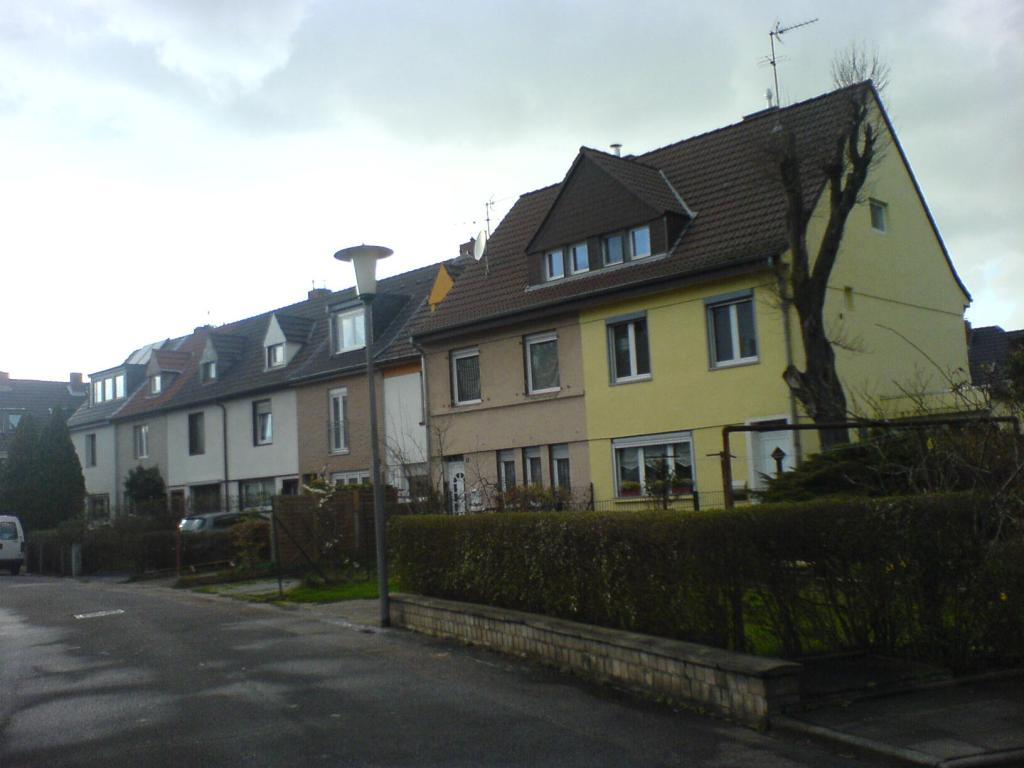Family is often presented as the most important form of human belonging.Anyone who doesn’t have a family or has lost their own family is just unlucky. A typical characteristic of kinship is, for example, similarity… More
The street where the Essing family’s house was
These are photos of the street in which the Essing family lived for a long time from the 20th century to the beginning of the 21st century.
The street is a biographical part of the life and experience of the Essing family.
The pictures are from 2007 and have long been history themselves.
It is not only the house itself where human existence is located, it is also the geographic and urban environment.
The street in which people live becomes an extended home. Every day you go out of the street and every day you come back into the street.
When you are tired or exhausted, the sight of the street in which you live signals that you have “arrived”.
The exhaustion or tiredness becomes less and you steer towards your own home.
You will never forget the street you lived on for a long time.
Here is a look into the street where the Essing family lived. It is a shot with sunset, and unfortunately a bit too dark, but very atmospheric. In the foreground is the Essing family’s car. The photo shows the east side facing the street.

These recordings are also from 2007. It is March 2007 and during the day. From the cross street you can see the street where the Essing family lived. The Essing family’s house is on the right-hand side, directly behind the yellow house.
It is the time before the facade renovation of the house where the Essing family lived.
The surroundings of the Essing family’s house
The Essing family lived in a small house in a suburb of Cologne for several decades in the 20th century.
It had a basement, a ground floor, an upper floor and an attic. The front of the house faced the east and the back of the house faced the west. The house had a small garden in the front and a small garden in the back. It was a row house.
The house was acquired by the Essing family at the beginning of the 20th century and was inhabited by the Essing family continuously until the beginning of the 21st century.
Although the neighborhood was densely populated, there were little green gardens and a glimpse of trees everywhere.
Unfortunately, the gardens facing the street were gradually converted into car parking spaces. This is what happened to the Essing family’s house, although there was still some space left for flowers, bushes and a very pretty little peach tree.
Here there is a winter view from the roof windows of the house of the Essing family, where you can enjoy the contemplative and calm winter landscape. The following pictures are from January 2009. The photo, taken in spring, dates from 2007. Most of these pictures were taken from the skylight, some pictures from the upper floor .

View of the back side surrounding to the left 
View of the back surrounding to front 
View of the back surrounding to front 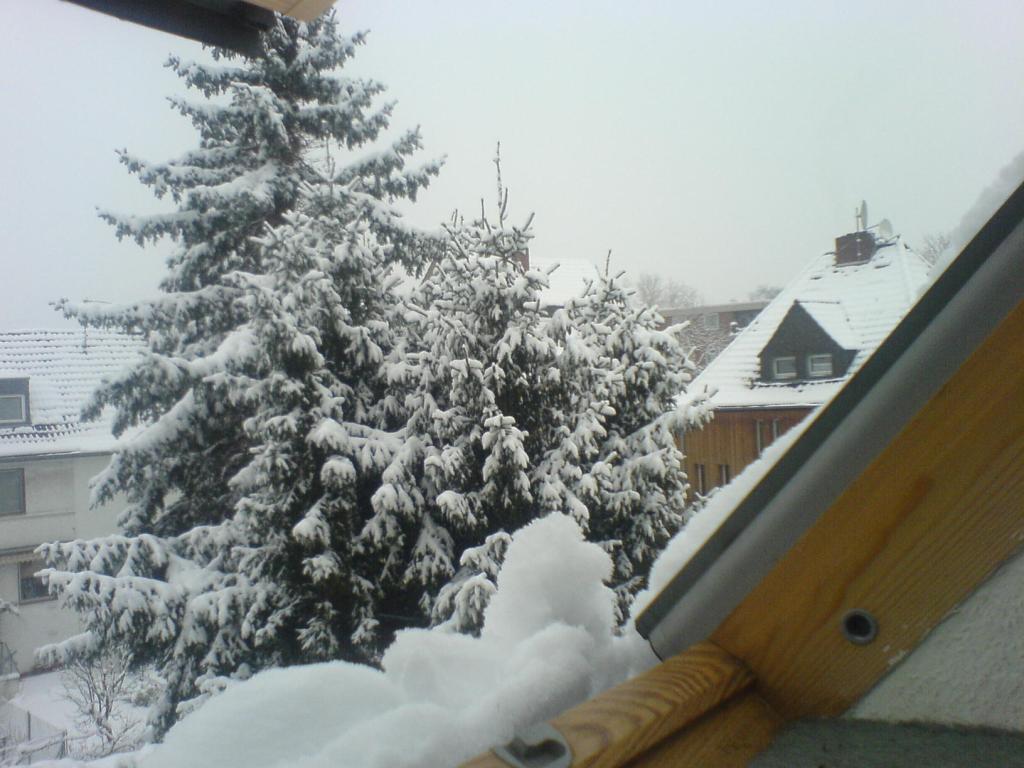
View of the back surrounding to the right 2009 
View of the back garden 2009 
View of the back garden 
View of the front of the street (from skylight) 2009 
View of the front of the street (from skylight) 2009 
View of the front of the street (from upper floor) 2007 
View of the front of the street (from upper floor) 2009 
View of the front yard, the old car and the houses opposite 2009 
View of the front yard, the house of the Essing family and the old car
All images from the Essing family home are copyright essingblog.wordpress.com
AI gives old portrait photos new life
It is always interesting to leaf through old photo albums. In the photos you can see the faces of people who have long since passed away, who seem strange and yet belong to their own biography.
And yet they remain distant and inaccessible. What would these people have looked like if they had moved, what would their animated faces have looked like?
The myheritage website offers a web tool with which the portrait photos of deceased relatives and friends can be displayed again with lively facial expressions. It is really amazing how lively and real a photo looks when facial expressions animate the portrait.
Family – happiness or disappointment

Each family has its own story designed by the family community. It is intuitively expected that the family itself has to be a place of happy get-together and mutual help. It is also proclaimed as a myth by various religious and social institutions.
Interestingly, the “happy family” is always represented in the composition “young parents and small children”. Perhaps this is the happiest and most carefree phase of the family. Family idyll is beautiful, but idylls don’t seem to be the stuff that life is made of.
So life tells different stories. Hostility, hatred and envy don’t stop at families either.
There is the mother of a large family who has stolen from her own son for many years. This woman was of the opinion that her children were to a certain extent her clan and she was the head of the clan and could direct the material goods and destinies in this clan as she saw fit. In old age she is robbed by her own daughter.
There are parents who explain to their children that they are their parents’ property. There are parents who do not tell their children the truth about their origins and do not tell other important things.
Often the desire for children arises not only out of pure parental love, but also out of a certain need for power. A woman who has children is more important and in a different position than a childless woman. In a sense, she founded her own clan. Children as a means of power, as a status symbol and as a means of pressure.
There is the man who leaves his wife and children and turns to a more decorative and younger woman. First of all, the children from the first marriage always come to visit; they are important, the family of the adventurous man. The young new wife is honey-friendly towards the children from the husband’s first marriage. Then the new woman will have a child herself. A mental death blow for the children from the first marriage. Family as an exchange package?
Some children disappoint their parents and take unfavorable paths in life. These children remain dependent on their parents for their entire life and visit their parents often – but with the intention of getting material advantages.
Siblings are competitors to each other and as adults they break off all contact with their children. There are siblings who lie to one another, steal from one another.
Sometimes it is also a stroke of fate that pulls families apart. There are the successful parents with the exemplary son who suddenly dies in his mid-twenties. The family biography collapses.
For example, some children die at a young age or at a time when their parents cannot have new children.
Mothers with many children are all alone in the nursing home and are not visited by their numerous children. What does family mean?
There are children who, after the death of their parents, constantly harass the funeral home with telephone calls because they really want to have money. There is the son-in-law yelling about not getting the porcelain from the deceased mother-in-law that he is supposedly entitled to.
Of course there are also nice families, where everything is as good and correct as it should be.
Image source: https://pixabay.com/photos/family-pier-man-woman-children-591579/
All people are related – but not necessarily families

Many genealogists take pride in their long and carefully maintained family trees. You can list the names of family members who have died long ago, know who married whom, know the names of the children and, again, their spouses and their descendants.
These genealogists feel fortunate because they believe they know their roots and perceive their own ephemeral biography in a continuous stream of a long line of ancestors.
But how reliable are these family trees? Are these people, whose names can be read in a family history, really biologically related to one another? One can doubt.
It is forgotten that reality can sometimes be different and that some children have arisen out of marriage. As a result, some siblings are half-siblings and there are different lines even where you don’t suspect it.
This unpredictability shows the difficulty of gaining precise knowledge of ancestry. Who is who, who comes from where?
So the maternal line remains the only certainty and family trees primarily show a sequence of “social families”, that is, of people who have lived their lives in family relationships, regardless of lineage.
Even if family trees do not always provide the desired information on the question of one’s own family ancestry, one thing is clear. Biologically speaking, we humans are all one big family. Maybe we should get on a little better with each other.
More informations: https://www.scientificamerican.com/article/humans-are-all-more-closely-related-than-we-commonly-think/
Image source: https://pixabay.com/de/photos/baby-jung-lächeln-kinder-mädchen-444950/
The old Cologne in video views
The beautiful city of Cologne has changed a lot over time. The city is no longer what it used to be. The members of the Essing family used to live in Cologne, but the environment was very different. What was life like in Cologne at the beginning of the 20th century?
What did the former Essing family members see when they moved to their hometown of Cologne?
In order to illustrate the life and daily environment of the former members of the Essing family, here are some interesting and informative videos that show the old Cologne at the beginning of the 20th century.
Essingblog at archive.is
To my great joy, I found that Essingblog at the website archive “archive.is” exists.
It’s nice that there is a website archive and that Essingblog finds itself there.
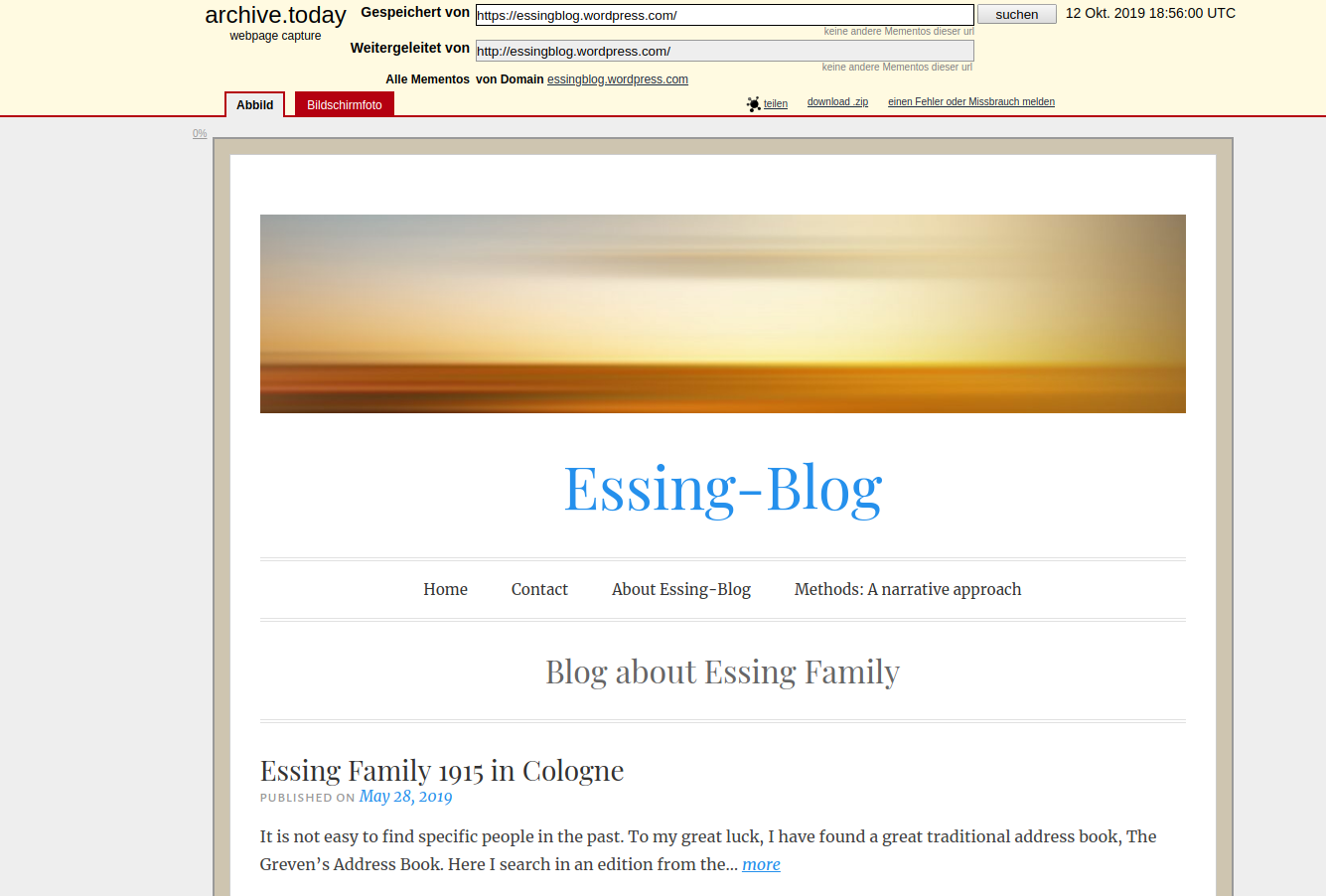
Essing Family 1915 in Cologne
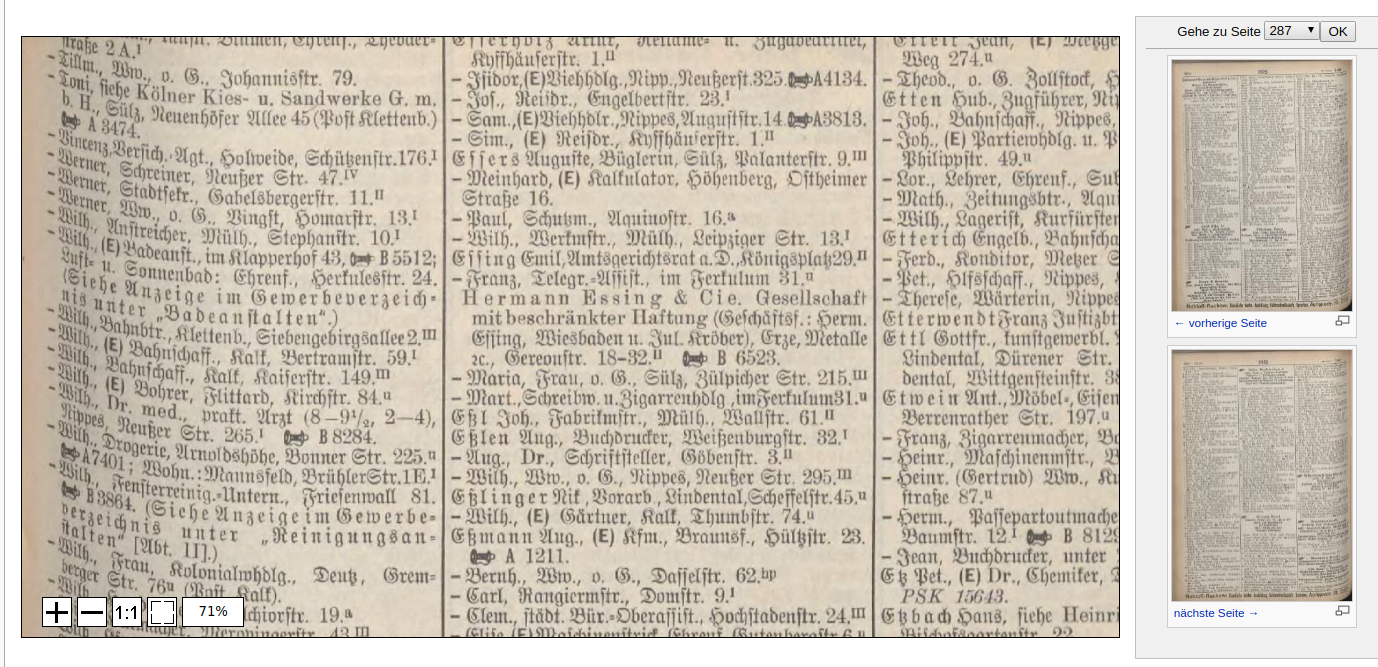
It is not easy to find specific people in the past. To my great luck, I have found a great traditional address book, The Greven’s Address Book. Here I search in an edition from the year 1915 for my ancestors from Cologne.
I was immediately lucky and found three interesting people:
Emil Essing, a county court retired in 1915, who lived at 29 Königsplatz.
Furthermore, I found Franz Essing. He was telegraph assistant in 1915 and lived in Ferkulum 31. Franz Essing was possibly the son of Emil Essing.
Maria Essing lived in Cologne in 1915 in Sülz on Zülpicher Straße 2015. Maria Essing was married to one of the above (Emil Essing or Franz Essing).
The other person’s first name was “Mart.” abbreviated. This person, Mart. Essing, had a shop for stationery and cigars at Ferkulum 31.
In addition, in 1915 there was a metals company, Hermann Essing and Cie. It was a limited liability company. Hermann Essing was managing director together with Julius Kröber. The company was possibly in Wiesbaden. Hermann Essing lived in Cologne in Gereonstraße 18 – 32.
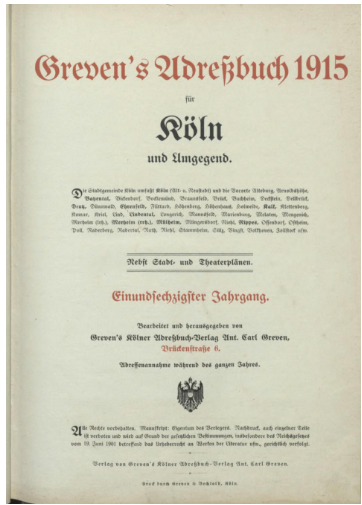
Family: Relationship is relatively

It is often assumed that people continue to live through their descendants. The production of progeny is sometimes even portrayed as the most important goal of personal life. But you can really believe that people really live in their children and later descendants?
The concept of family is very mystified by such interpretations, it takes inappropriate quasi-religious. traits. But if you look at the sober facts, a different picture emerges. Thus, the proximity of the genetic material is halved from generation to generation. While the children still share 50% of the inheritance of the parents, the grandchildren only share 25% of the inheritance of the grandparents. With the following generation there is only a similarity of 12.5 %, with the next generation only a similarity of 6.25 %. Thus, the biological relationship of a family develops from generation to generation to a homeopathic dose.
What does this mean for genealogical research and for Essing family? The term family is primarily historical. Biographical stories are told and fragmented from generation to generation are passed on. Although members of a family and of Essing family are more or less loosely linked to each other, each member is unique.
Image Source: https://www.pexels.com/photo/photo-of-family-on-seashore-1574653/
Greven’s Address book 1915 as a source
 At the beginning of the 20th century, the “Greven’s Address Book ” (Greven’s Adreßbuch) was popular in Cologne and the surrounding area.
At the beginning of the 20th century, the “Greven’s Address Book ” (Greven’s Adreßbuch) was popular in Cologne and the surrounding area.
The 1915 address book contains names and addresses of the inhabitants of Cologne and the following neighbourhoods:Cologne (Old Town and New Town), and the suburbs Alteburg, Arnoldshöhe, Bayenthal, Bickendorf, Bocklemünd, Braunsfeld, Brück, Buchheim, Deckstein, Dellbrück, Deutz, Dünnwald, Ehrenfeld, Flittard, Höhenberg, Höhenhaus, Hohlweide, Kalk, Klettenberg, Komar, Kriel, Lind, Lindental, Longerich, Komar, Mannsfeld, Marienburg, Melaten, Mengenich, Merheim (left side), Merheim (right side), Mühlheim, Müngersdorf, Niel, Nippes Ossendorf, Ostheim, Poll, Raderberg, Radertal, Rath, Rieh, Stammheim, Sülz,Vingst Volkhofen Zollstock and some other suburbs.
The book dates back to 1915 and is already the 61st vintage. The book is divided into two parts. At the beginning of the book, institutions, offices, schools, associations and companies are listed. Only in the second part will the private individuals be listed. Private individuals are given the first name and surname, as well as occupation and address.
In my opinion, the Cologne Adress book very exciting and I hope to learn more about the Essing family here.


